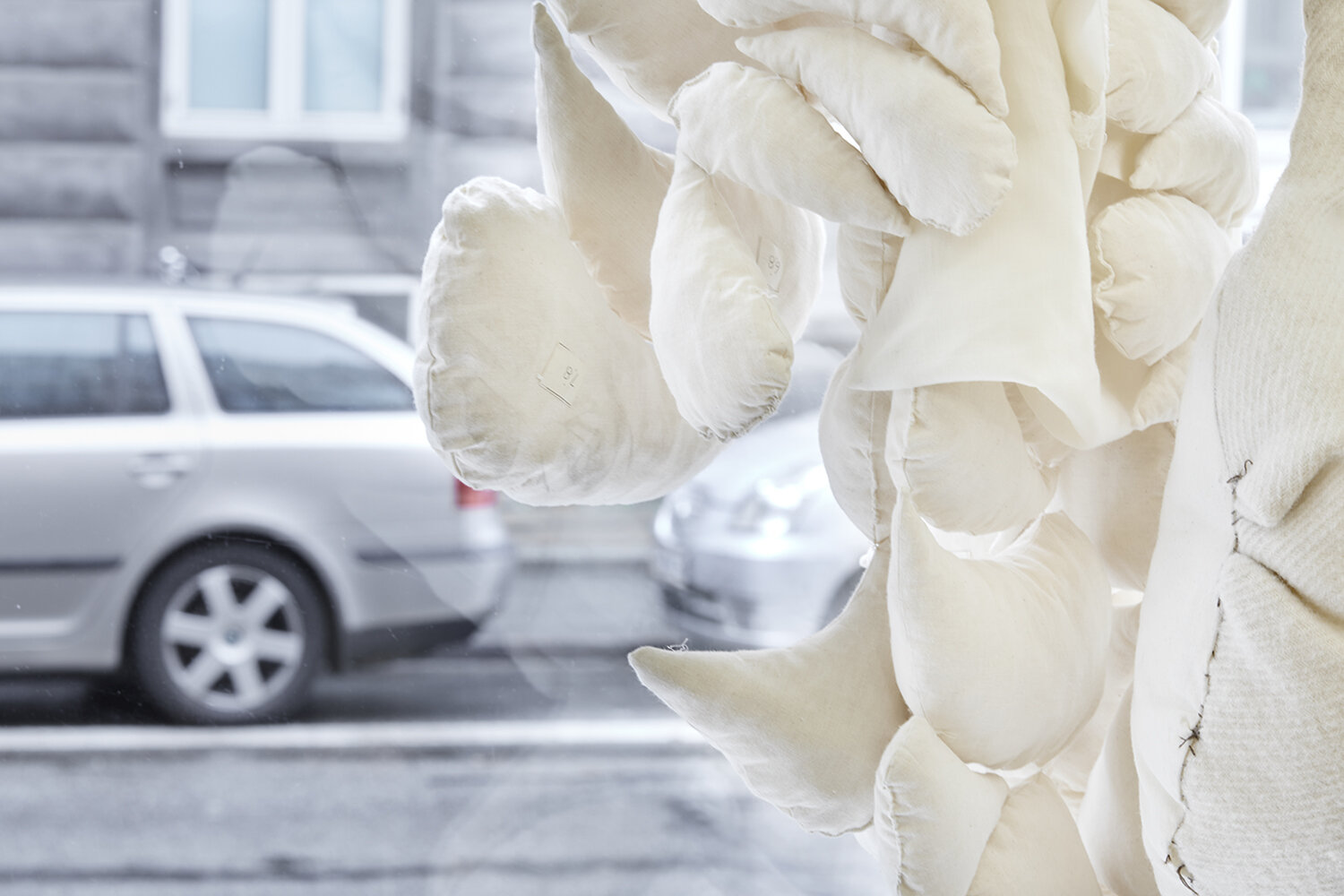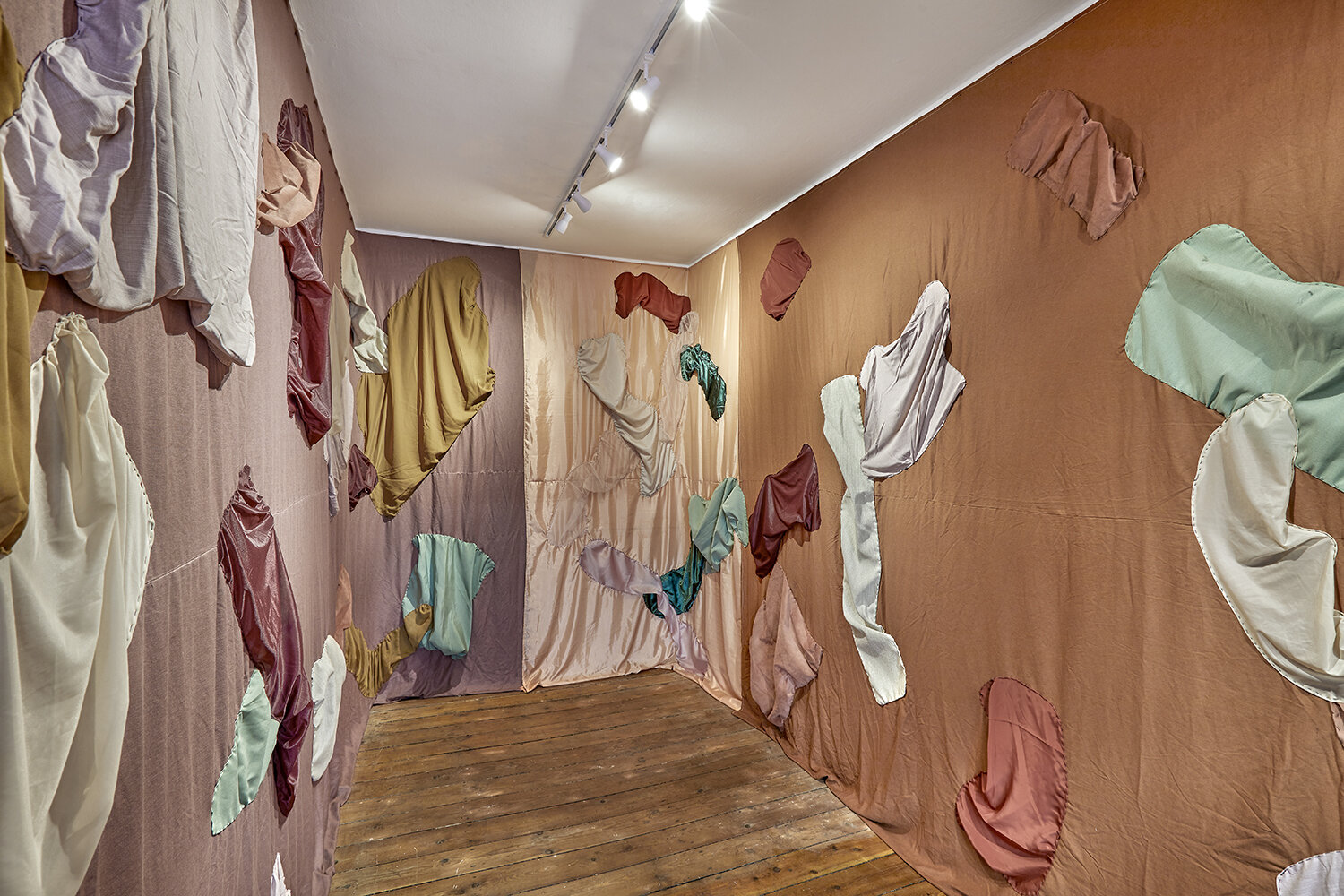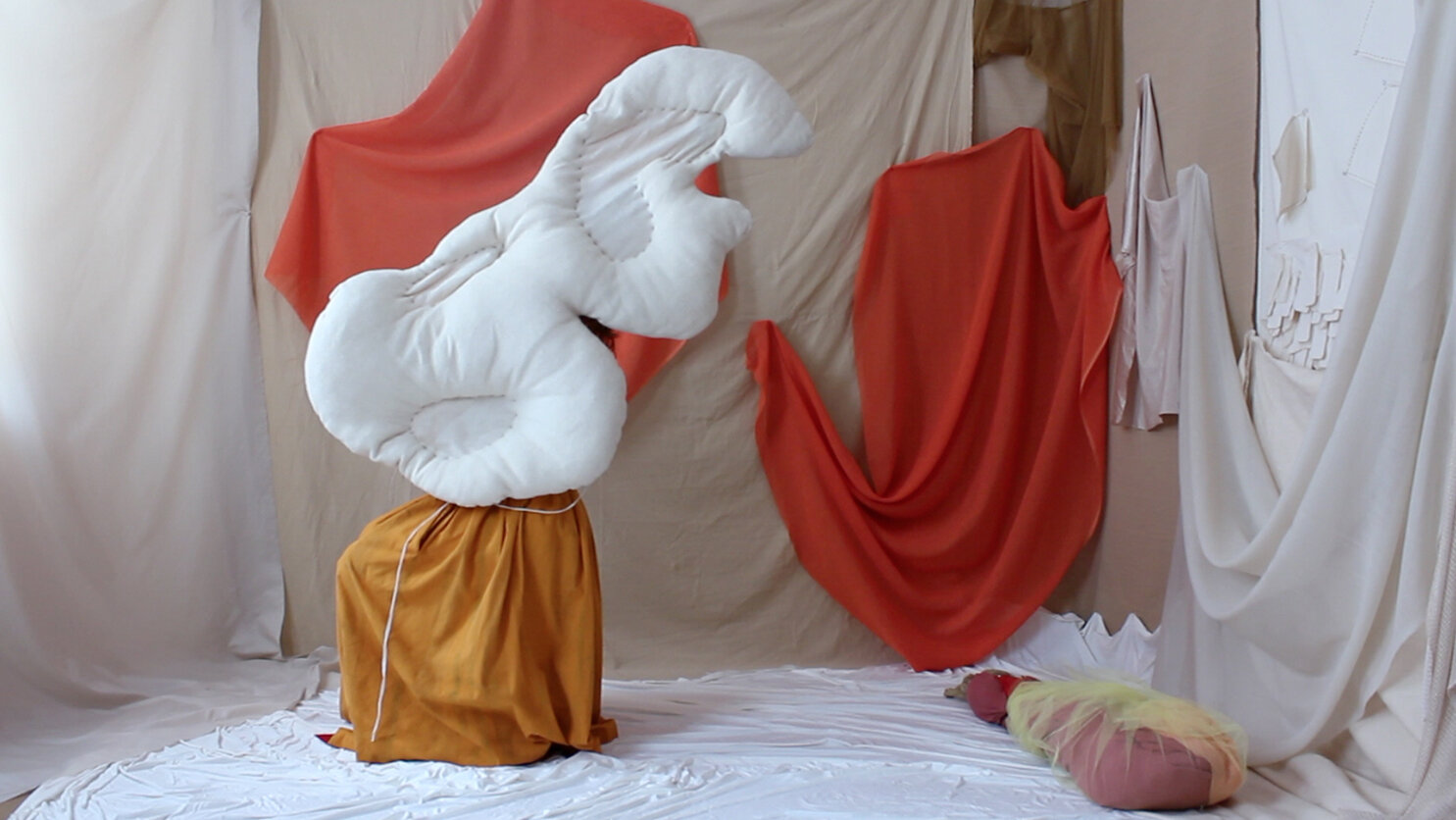SEWING BEYOND FORMS AND BODIES

In Paraguay, we have a beautiful lace made from cotton or silk using a needle and thread. It was brought to the country by the Spaniards, and mastered by the “mestizas” (mixed-race women). It became such an important symbol for the country that it lost its original name and was baptized under the name “Ñanduti”, a Guarani (1) term meaning “spiderweb”. The real origin of its meaning has not yet been confirmed, although its resemblance to a spiderweb is indisputable. In addition to the precision and diligence that go into making the lace, the beauty of its craft lies in the fact that each weaver gives her own sensibility and aesthetic to the lace by recreating her own world on it. Just like the Spaniards introduced their crafts to South America, the history of textiles is a history of exchange and acculturation.
From the West's colonial encounters in the late 15th century, the contrast between the two worlds was evident. And although certain garments indicated the status of the person within their communities, the near-nudity of the indigenous people contrasted the theatricality of the garments of the Europeans, who used clothing as cultural norms to attend moral demands.
Signe Maria Friis, Unveiling Forms: Beyond Me. SixtyEight Art Institute, 2020. Photo: Jenny Sundby.
Sewing is an ancient practice and almost every native community around the world has a history of textiles as a fundamental pillar in the construction of their cosmovision. Moreover, winding, threading and sewing have usually been imagined as feminine occupations tending to thrive in the realms of female domesticity, the home, to create shelter and comfort.
I still remember my grandmother patiently sewing garments for me when I was a little girl, or the big tapestries my mother (a very restless woman) stitched when she had to spend 8 months lying down due to a complicated pregnancy with my brother. Just like the political act of silently sewing at home or growing a new life inside the body, at "Unveiling Forms: Beyond Me”, we see Signe Maria Friis gathering, sewing and arranging fabrics in peculiar ways and shapes in order to create her own cosmos and give birth to new ways of (de)constructing ourselves.
Signe Maria Friis, Unveiling Forms: Beyond Me. SixtyEight Art Institute, 2020. Photo: Jenny Sundby.
It is an autumn afternoon when I arrive at Gothersgade 167 in the center of Copenhagen for an opening that I still do not know much about. An unusual white flag made with assorted pieces of fabric is hanging outside of SixtyEight Art Institute. The name of the artist and the exhibition are not written in the front of the space, and the flag seems to anticipate the new and unknown territory that we are about to enter; it presents itself as the personal emblem/allegory of the artist. Last year Friis – a 27-year-old artist and a student at the Funen Art Academy – participated in Kunstnernes Efterårsudstilling (The Artists’ Autumn Exhibition) (2) where she was the recipient of the KE Prize 2019, awarded by SixtyEight Art Institute. Through installation, performance, video and sculpture, she creates a universe of colors, organic shapes and textures. In a constant sculptural construction with fabrics and with her body, the exhibition is based on “Friis’ investigation of whether there is potential in objects for transforming oneself into an abstract figure” (3). The two videos presented in last year’s exhibition were the starting point for “Unveiling Forms: Beyond Me”, developed as a project of SixtyEight and curated by Lise Grüner Bertelsen, who has been collaborating with the institution as a curator, writer and assistant editor at RSS Press (SixtyEight Art Institute‘s independent publishing arm).
Signe Maria Friis, Unveiling Forms: Beyond Me. SixtyEight Art Institute, 2020. Photo: Jenny Sundby.
Signe Maria Friis, Unveiling Forms: Beyond Me. SixtyEight Art Institute, 2020. Photo: Jenny Sundby.
From the street, we can see a white sculpture on display in the window of the exhibition space. At first sight, it seems like a prototype: numbered volumes, materials and shapes piled and hung up. Yet, after some time, I can see the balance and the meticulous construction of the piece. Friis’ choice of simple materials to reflect on sculpture in an inventive and emotional way references the work of Eva Hesse, as Bertelsen, draws to our attention. It is titled “you wanted to speak to the forms, therefore you wanted to move”, and beyond it we move into an extensive sensuous world inside the exhibition space where abstraction, reality and fiction find each other.
When entering the exhibition space, one cannot help but go to the second or backroom of the exhibition. While in the first room the ‘white cube’ aesthetic has been preserved, in the back it has been completely transformed by textiles that are carefully installed and which cover the entire width and length of the walls. Organic shapes sewn in different materials stand out from the fabrics, which have colors as warm as the lighting. They require you to get closer to the piece (titled, “I followed your movements and was consumed by a being-with-you”) to see the details.
Signe Maria Friis, Unveiling Forms: Beyond Me. SixtyEight Art Institute, 2020. Photo: Jenny Sundby.
Perhaps it is because I arrived in the country just a few months ago, or maybe it was a deliberate choice of the artist but, in any case, the feeling of warmth is appreciated. It appeals to my sense of touch and reminds me of the privacy of blankets and duvets (cobijas). In Spanish, “cobija” refers to “blanket” and/or “duvet”; however, the verb “cobijar” means “to give someone shelter or protection”. The installation triggers within me associations related to home and the female body as a refuge/shelter during the early stages of conception and early years of childhood.
Yet I was already in Denmark before I even arrived. As is common in this era, my journey to the North began on the Internet more than 11.000 km away. Months before coming to Copenhagen, I started researching independent art spaces in the city. This is how I came across SixtyEight Art Institute and its open call for “The Curatorial Thing” (4), a 9-day intensive curatorial program consisting of workshops, lectures, exhibition and studio visits. From afar, I found the concept of SixtyEight (5) and its beginnings to be very interesting. From up close, I met a diverse and international group of artists, curators and practitioners with different backgrounds and experiences. The organization has had a more central location for five years now, but one can still feel the sense of community. This unpretentiousness and diversity in their approach is what makes it an intimate space, especially for a newcomer like me.
Signe Maria Friis, Unveiling Forms: Beyond Me. SixtyEight Art Institute, 2020. Photo: Jenny Sundby.
Signe Maria Friis, Unveiling Forms: Beyond Me. SixtyEight Art Institute, 2020. Photo: Jenny Sundby.
Signe Maria Friis, Unveiling Forms: Beyond Me. SixtyEight Art Institute, 2020. Photo: Jenny Sundby.
Moving back to the present moment and moving forward into the first room, we can see a more ‘finished-looking’ sculpture (than the one in the window of the space) installed on one of the walls. The piece, which does not have a title, is also evocative of the body. It is made of oppositions; materials such as raw cotton and cotton textiles, which are combined with fabrics that imitate animal skin. I think about the primitive use of sewing where it was used to stitch together animal hides. Tiny beads (stone-like imitation jewelry), often used to decorate women's wardrobes, are embroidered. Just like the embroidered beads, garments are often used as ‘ornaments’ for ourselves to serve as a shelter from the outside.
Signe Maria Friis, Unveiling Forms: Beyond Me. SixtyEight Art Institute, 2020. Photo: Jenny Sundby.
Signe Maria Friis, Unveiling Forms: Beyond Me. SixtyEight Art Institute, 2020. Photo: Jenny Sundby.
On another wall, three big white pieces of fabric with ‘21 pockets’ are installed (“as the days passed”). During 3 weeks (and 21 days), the artist will visit SixtyEight to fill in the pockets/days. According to the curator, the artist has worked on keeping a diary to create a routine and will do so as a sort of meditative process. “Signe Maria Friis creates her own ritual processes and expands them into basic forms of role play and installation” – states Bertelsen. In popular culture, the number 21 is related to “change and new beginnings” and the myths around the spiritual aspect of the number are broadly extended on the Internet. “In this work, Friis touches on a performative approach as she will be activating these pockets during the exhibition period through her own intuitive actions” – the curator continues. Some days are marked with new shapes, while others remain open/empty. Just as this evolving sculpture represents a visual journey of the life of the artist in the exhibition space, so it does on her Instagram account.
Signe Maria Friis, Unveiling Forms: Beyond Me. SixtyEight Art Institute, 2020. Photo: Jenny Sundby.
People of my generation experiment with life beyond the physical space of our lived experience. Signe Maria Friis was born in 1993, and the playful way she presents herself on Instagram may be an honor to our peers. Her social network is a work-in-progress, a reflection on the creative process. Just like clothing through history, social media in contemporary culture appears as a space to perform and show our “best selves” to others.
In the work of both galleries (online and offline) Friis’ presents a micro-politics of existence, by raising questions about the norms and (pre)conceptions with which we go through life, in a constant search to dissolve the notions of time and space, and merge sculpture and body.
Signe Maria Friis, Unveiling Forms: Beyond Me. SixtyEight Art Institute, 2020. Photo: Jenny Sundby.
Signe Maria Friis, Unveiling Forms: Beyond Me. SixtyEight Art Institute, 2020. Photo: Jenny Sundby.
Signe Maria Friis, Unveiling Forms: Beyond Me. SixtyEight Art Institute, 2020. Photo: Jenny Sundby.
Lately, everything starts on the screen.
Earlier this year while checking my Instagram account, I surprisingly came across Ñanduti classes online (it is still unusual to see knowledge of traditional crafts and the internet encountering each other). I signed up for them in an attempt to dig more into my country’s own history. And just like that, after a few days and a few online transactions, I was weaving a “spider web” with women of different ages and nationalities, each of them in the comfort of their homes during the lockdown. As paradoxical as it is in times of hyperconnectivity, where the need for “real connection” is significant, these two binary systems worked as a shelter from the chaotic outside reality, amplified on every screen, in every part of the world.
The imagery seen on Friis' Instagram gallery is expanded in the two videos installed on the opposite wall of the exhibition space. Here, the viewer can see the artist interacting with the built scenery with a sense of humor. Figures and objects are covered with fabrics of different colors and textures creating a surreal whole. In the videos (titled, “we were going to unfold together here. you asked me to remember my dance” and “now we were to talk, I said ok let's talk”), she plays with spatiality, audio, her body and with shapes, dancing, relating to objects, doing and undoing, and “relearning” how to move. We hear words that intersect and merge. The voice, just like the titles of the works that make up the exhibition, seems to portray an introspective dialogue between the artist's mind and her body. She explores and connects with the objects; entangles and dissolves into them. The space on the other side of the screen becomes a great abstraction.
Signe Maria Friis, Unveiling Forms: Beyond Me. SixtyEight Art Institute, 2020. Photo: Jenny Sundby.
As much as I would like to see these acts taking place outside the screen, in the “real” space of SixtyEight, the videos seem to be an edited and more choreographed version of her Instagram performances.
We can say that the artist is adding an extra layer to the construction of herself for others, considering the online gallery as the “mundane” and the offline gallery as the “sacred”. In this regard, I am not too sure why she is blending the virtual with the physical. Perhaps, it is to create a new vision for the two. Perhaps she is doing so to integrate into a new banality or normal. Either way, this is rich ground indeed for all artists in the near future.
Signe Maria Friis, We were going to unfold together here. you asked me to remember my dance (Video still).
Signe Maria Friis, We were going to unfold together here. you asked me to remember my dance (Video still).
Signe Maria Friis, Now we were to talk, I said ok let's talk (Video still).
Signe Maria Friis, Now we were to talk, I said ok let's talk (Video still).
Signe Maria Friis, Now we were to talk, I said ok let's talk (Video still).
With the accessibility of smartphones guided by global hyperconnectivity, one can easily relate Friis’ uses of social media to the early origins of video art. For example, in the early 1960’s Sony released the first low-cost portable video camera onto the market. The medium – until then restricted only to broadcasters – became accessible for artists, and a little later the appearance of the 3/4" VHS cassette in the 1970’s facilitated the distribution of this new form of art. In the sixties, an era marked by a tumultuous political arena, many artists chose video art as a form of critical analysis of societal values for its sense of immediacy and temporality. To a very real extent, those early characteristics of video art and its light-emitting screen remind us, nowadays, of the intimacy of our phones.
Knowing that Instagram and the use of her body are Friis’ mediums and performative tools, the artist's debut shows promise and an idea as to where this young artist will take her practice. How she avoids the traps of too much self-reproduction and self-involvement will surely be something to follow.
Signe Maria Friis, Unveiling Forms: Beyond Me. SixtyEight Art Institute, 2020. Photo: Jenny Sundby.
In one of her photos on Instagram, dated January 21, 2019, we see Friis comfortably lying down, sleeping on her textiles, with the caption “Her kan jeg leve” (Here I can live). In ‘Unveiling Forms: Beyond Me’, Friis reveals not only forms but also new ways of moving, of being, of living and sets us free. While looking at the photo, I wonder: Who would not want to be in this cosmos portrayed by the artist? Maybe it is time to reset and rethink.
Is it possible to re-shape the world as we know it, by re-imagining new forms and pillars to build a colorful territory that could feel like a (common) shelter? As fantastic and fanciful as it sounds, I allow myself to reflect on that. After all, we are all entangled by one big spiderweb.
The unusual white flag comes back to my mind (the one hanging at the front of the exhibition space), this time as a symbol of peace and redemption in this fragile world, and as an entry point to a universe created not only for and by an Internet generation but, like the Ñanduti, as a hybrid space that allows us to weave threads to the multiple metaphors of sewing.
As the artist says in one of her videos – “Remember to remember”.
Guaraní is an indigenous language spoken in several countries in South America. It is one of the official languages of Paraguay (along Spanish) spoken by 90% of the population, including the non-indigenous people.
Kunstnernes Efterårsudstilling (KE) is a censored exhibition for contemporary art, formed in 1900 as an alternative to Charlottenborgs Forårsudstillingen, wich at the time only accepted works by students of the Royal Danish Academy. Since then, it has existed as a contemporary arts organization and a pathway into the professional art world, where everyone can have their works judged by creative professionals, independently of network and background. The board of the award jury that chose the work of Signe Marie Friis consisted of the Institute's director Christoper Sand-Iversen; artist and head of advisory board Hugo Hopping; anthropologist Kit Glæemose; curator and writer Lise Grüner Bertelsen; and art critic and curator Staffan Boije at Gennäs.
Excerpt from the curatorial text.
“Under the concept of a ‘thing’, an old Nordic concept for a meeting place, an assembly of the community, or what can be defined as the precursor of the modern term 'parliament' SixtyEight Art Institute annually invites a range of Nordic-based and international speakers to address the various potentials opened by exhibition-making.”
68 Square Metres (the organisation’s first and previous name) was established in 2011 in an old factory in East Amager, dedicating 68 m2 of an old laboratory to exhibit contemporary art and the production of cultural activities in the neighbourhood. Now, artistic and curatorial research, exhibition space and editorial production are gathered all in one intimate space in the center of Copenhagen.
This essay is part of an initiative to foster Danish and English Language critical writings from a range of new talents across the visual arts; and as a partnership between I DO ART and SixtyEight Art Institute.
Ana Baumann (b. 1986) is a visual artist with combined experience in project coordination, curatorial practice and communications. She studied Film (FUC) and Photography (ENFO) in Buenos Aires before attending the International Center of Photography (ICP) in New York. Ana has contributed to idoart.dk since 2020.


























